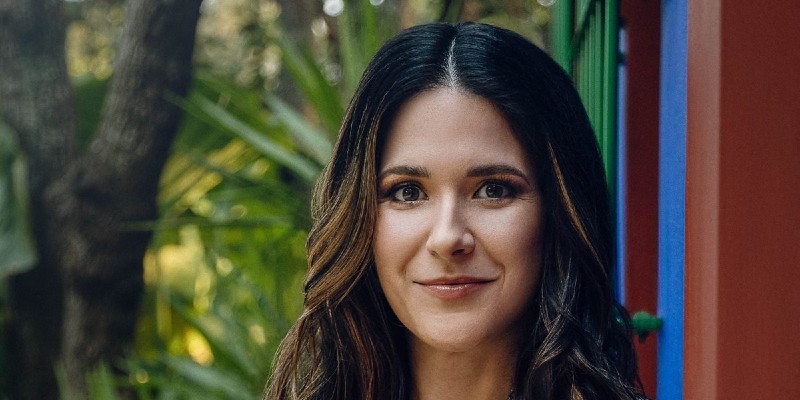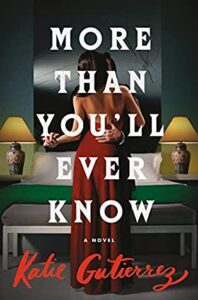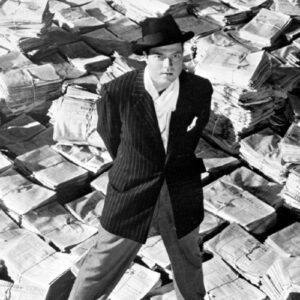I first met Katie Gutierrez at the Edgar Awards ceremony in the spring of 2023.
I was impressed by her honesty and her kindness. I didn’t know much about her work at that point. I had no clue her debut novel, More Than You’ll Ever Know, had been selected as a Good Morning America Book Club Pick that June. I didn’t know she’d written for Time, or been nominated for a National Magazine Award.
I just knew Katie was good people.
It wasn’t until I read More Than You’ll Ever Know that I began to understand just how talented Katie really is. Her lines are tight, her characters three-dimensional. On a structure level, Katie’s books are sprawling and experimental in all the best ways. Which led me to wonder how in the heck had she pulled off such complicated, veteran moves?
After completing this interview, I realized the answer was simple: Katie Gutierrez works really damn hard at her craft.
Eli Cranor: Give me a recap of your journey. The early days. The query trenches. The agent. The whole come-up story, in a couple sentences. No pressure.
Katie Guiterrez: Yikes, okay: wanted to be a writer, always. Fell into journalism when my college internship at People magazine turned into my first post-grad job, then into freelancing when the Austin bureau suddenly closed six months later. Spent the next 10 years (including three getting my MFA) writing for whoever would pay me—community newspapers, niche magazines, white papers, copywriting—and editing books from job ads I found on Craigslist, which turned into a full-time gig with a boutique storytelling company. I edited about 70 books, mostly nonfiction, over five years, and co-wrote seven or eight. In 2015 I left that job, which I loved, to try to write my own novel. Queried in 2017 and received five offers of representation within three weeks—but that book didn’t sell on submission. I started More Than You’ll Ever Know to take my mind off the anxiety of being on sub, wrote the first draft over 18 months—including a difficult pregnancy and sleepless newborn months—then edited it with my agent for the next 18 months, over a second difficult pregnancy and right up to the weekend I delivered. We went on submission on Friday, September 11, 2020, one week after I gave birth. By the next week I had calls with multiple editors, which I took from bed, with my newborn attached to my boobs. The book sold in a pre-empt to Penguin Michael Joseph in the U.K. that Tuesday, then to William Morrow in a pre-empt that Friday, exactly one week after we went on sub. I still get a ridiculous grin when I think about the whole thing. And this was more than a few sentences, sorry.
EC: Apology accepted. Those extra lines were so worth it. Do you write every day?
KG: Not even close. When life is “normal,” I’m ecstatic if I can write three mornings a week. My kids are five and three, and my three-year-old was sick constantly over the fall. Recently I’ve been going through a health crisis myself and haven’t written in over a month. On days I can’t write, or the session is cut short, I still try to connect with the project somehow: reading/studying a novel that feels in conversation with the book, or listening to a writing podcast (I like “The Shit No One Tells You About Writing”) while cleaning, or reading interviews like this! When I was hospitalized in December, I took copious notes on all my nurses, because two of my characters are nurses. Also, I love to dedicate the time as I’m falling asleep to letting my mind wander around the book. It’s almost like lucid dreaming. I’ve solved so many problems this way, or heard a character’s voice in such clarity that I suddenly know them, or experienced a sentence or paragraph rolling across my mind that’s ends up in the final draft. The little things add up, and staying in a creative space matters, even if I’m not actively writing.
EC: That pre-sleep thing is for real. Pure magic. When you’re working, do you aim for a daily word count?
KG: Before kids, I used to hold myself to a daily word count. Then my daughter was born and writing sessions became a race against the clock: I’d put her down to nap, make coffee, sit at my desk with the baby monitor, and write until she woke up. Aside from when my husband had her, I wrote and edited most of More Than You’ll Ever Know that way. At first, I tried to impose word goals, but I always fell short and then felt bad about myself. Now it’s the time itself that matters. And it also depends on the project and what phase it’s in. If I’m drafting, maybe I’ll write 500 words, maybe 1,000, maybe I’ll edit half a chapter and actually delete words, maybe I’ll fall down a research rabbit hole and write one sentence. It’s all forward motion.
EC: What are the tools of your trade? Do you write using a laptop, a pen, a typewriter?
KG: I would love to be a typewriter girl; maybe one day. When I was fifteen, though, and working on a novel, my parents bought me an IMB ThinkPad, a bulky black laptop with a satisfyingly deep keyboard and a velvety red TrackPoint right in the center. I carried it with me everywhere, like a purse dog. Ever since then, I’ve written on laptops. I draft on Scrivener—I love its ability to give me a bird’s eye view of the project, chapter by chapter, scene by scene. I can split screen between two chapters or POVs, or a chapter and my research, and if I start to get lost, I can return to my cork board outline. If I’m feeling too much pressure at the laptop, I use my reMarkable paper tablet, which my husband gave me for Christmas a few years ago. I freewrite by hand, then click to convert the handwritten notes to digital across the app, so I can put it directly into Scrivener for editing. It feels like a huge hack for me!
EC: Definitely a cool hack. My interview with Danya Kukafka got me to try Scrivener, but alas, I’m still just a pen and pad guy. When do you write?
KG: I write when I can’t see or hear my children. Ha! Babies are famously sedentary, so it wasn’t as hard to write while keeping an eye on them (though I thought it was at the time), but young kids, have relentless and usually very loud demands. It’s much harder to slide into the creative slipstream, so if I need to work while multitasking with them, I handle more administrative things, like emails. But writing, for me, now, has to be done away from them. Ideally, I’d write from 9:30 to 1:30 every day—the hours, theoretically, they’re both in school—but as I’ve mentioned, that doesn’t always pan out. Sometimes, if I’m feeling particularly desperate, I’ll write at night, after they’re in bed. I love sitting in bed with my laptop, dim light, and a glass of wine. But then I’m wired and can’t sleep and I’m a mess the next day, so, sadly, I’m usually a daytime writer.
EC: Do you have any rituals you return to that get you in the mood to write?
KG: This is so quotidian, I feel like the least interesting writer in the world, but I like to clean up the kitchen before I sit down to write. By then three hours have passed since I woke up, and in theory I’ve just returned from dropping my second child off at preschool. Physically cleaning the breakfast mess is like clearing space in my brain, a divider between the time of day I belong to others and the hours I belong only to myself and the work. After that, I make my second cup of coffee—the first is medicinal, the second for pleasure—and sit down. A quiet room, natural light, and a fresh, hot cup of coffee: these are my ideal conditions.
EC: Do you outline your novels? Just dive straight in? Or do some combination of the two?
KG: I always start with a hook—some situation that’s gripped me—and the characters. In the past I’ve loved using Proust’s questionnaire, a parlor game that Proust supposedly believed would reveal the essence of a person if every question were answered honestly. This time around I’ve tried Lisa Cron’s Story Genius method, which centers around finding characters’ “misbeliefs,” origin scenes, and turning points, and I’ve found it difficult and very helpful. My friend Sara Sligar, author of the excellent Take Me Apart and upcoming Vantage Point (get excited because it’s brilliant), also introduced our writing group to using Enneagrams to help drill further into characters’ psychology, and that’s been staggeringly useful. I’ll usually write between 20-40 pages per lead character.
The plot gradually emerges during this work. Once that happens, I write a 20-page-ish synopsis—which is a horrible, masochistic exercise but also, I regret to inform you, incredibly useful to me. Then I like to use Scrivener’s cork board (digital index cards) to jot down any scenes that came up while I was working on the characters and synopsis, and arrange those into a loose outline. I’ve tried using beat sheets to wrap my head around pacing, but that usually messes me up; it makes me feel like I’m trying to squeeze the story into predetermined fence posts when the story’s not a fence, it’s—I don’t know—a parachute. Something that doesn’t fit into fence posts. Plus, I love to play with structure, and so much of that requires experimentation. So while I like to have some idea of where the story is heading before I start writing, I also need to be open. That’s the fun of it, right?
EC: Amen. The fun, for me, is in the writing. Always. When you’re done with the first draft, what does your revision process look like?
KG: My general process is this: once I have a full draft, I convert it to Word and print it out. I edit by hand, then in Word, unless there are deep structural edits or more of a rewrite, in which case it’s back to Scrivener. Once I’m editing with others, say my agent or editor, then it stays on Word unless I need to privately move back over to Scrivener, then copy/paste into the existing tracked Word doc. As needed, I’ll print the whole thing out again and go by hand. I always prefer reading on paper over screen, and I love the tactile sense of editing by pen versus Track Changes.
The process for each novel so far has variations, though. The novel I wrote in 2015, I sent to a few trusted readers—both writers and non-writers—and then edited for several months before querying. With More Than You’ll Ever Know, I already had my agent, Hillary Jacobson. I sent her my synopsis, then the first 200 pages. My first complete draft was 600 pages, and I couldn’t do that to her or anyone else, so I revised it myself, with a major restructure and cuts, and got it down to a slim 450. My sister and my friend May Cobb read it then (my sister had been reading all along). I revised again. Then I sent it to Hillary, thinking it was in good condition. Cue the start of about a dozen rounds of revision with her before we submitted it in 2020. After that, I edited it with my U.S. and U.K. editors for another year.
After More Than You’ll Ever Know was published and I started working on my second contracted novel, I had so many voices in my head post-publication that I wanted to work completely solo until I had a draft worth sharing. Two years and three false starts, each varying between 50-100 pages, later, I’ve scrapped that draft and moved onto a new project. So I don’t think attempting to write in a silo worked for me. This time, with the new project, I’ll share pages and/or brainstorm with my cherished writers’ group, my sister, and my agent and editor at various touchpoints. I’ll let you know how it goes!
EC: Please do! Do you read certain books for inspiration prior to writing? If so, what are they? Do they change from manuscript to manuscript?
KG: I read books for inspiration all throughout the writing process, and the ones I turn to change based on what I’m working through. If I’m struggling with pacing, I’ll read a thriller. If I’m thematically dealing with a subject, say motherhood, I might read another book that approaches a similar theme in a totally different genre. Two writers I return to over and over for inspiration are Luis Alberto Urrea and Jesmyn Ward. Reading their work always reminds me what the novel can do.
EC: Best advice for writers just starting out, especially when it comes to the actual act of writing/developing the habits necessary to craft an entire novel.
KG: Read anything that gets you excited, keeps you up at night, thrills you with a sentence. Read within and outside your genre—read for the joy of it, but also study why those books, or single chapters, scenes, paragraphs, or sentences in those books, work. Make friends with other writers—Twitter used to be my place for this, but online or local workshops/classes might be another great option—and get the in the habit of reading each other’s work and learning how to give and, importantly, receive helpful feedback. Check out craft books from the library if classes aren’t financially feasible. As far as a writing practice, the most important thing is that it’s sustainable. Is it 20 minutes a day using a timer? Great! Is it from 10 p.m. to midnight once the kids are in bed? Do that. Is it three hours every Saturday morning? Perfect. Writing is an art, but as you said, it’s also a habit. The only way it’ll stick is if it fits into your life. Prioritize it, protect it, but also be gentle with yourself when life gets in the way, as it always will.
EC: Finally, why do you write?
KG: Elizabeth Bishop wrote that “What one seems to want in art, in experiencing it, is the same thing that is necessary for its creation, a self-forgetful, perfectly useless concentration.” That last phrase has stuck with me for fifteen years, because it encompasses the best state of writing fiction for me—when everything else disappears, including myself, in the creation and discovery of a story. I’ve been addicted to that feeling since I wrote my first story at eight years old. Writing fiction is a compulsion for me, a necessary part of my existence. Without it I feel hollowed out of the good stuff, like a shallower participant of life.
When I write nonfiction, I often write essays in direct, immediate, and passionate response to current events or events in my own life, and the features I most love (mostly for Texas Highways) connect me to my state and my culture in ways that feel very fulfilling. Writing nonfiction has influenced my fiction writing, too. It’s made me more exacting and concise. I hope to avoid another 600-page first draft.


















